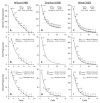Estimating limits for natural human embryo mortality
- PMID: 28003878
- PMCID: PMC5142718
- DOI: 10.12688/f1000research.9479.1
Estimating limits for natural human embryo mortality
Abstract
Natural human embryonic mortality is generally considered to be high. Values of 70% and higher are widely cited. However, it is difficult to determine accurately owing to an absence of direct data quantifying embryo loss between fertilisation and implantation. The best available data for quantifying pregnancy loss come from three published prospective studies (Wilcox, Zinaman and Wang) with daily cycle by cycle monitoring of human chorionic gonadotrophin (hCG) in women attempting to conceive. Declining conception rates cycle by cycle in these studies indicate that a proportion of the study participants were sub-fertile. Hence, estimates of fecundability and pre-implantation embryo mortality obtained from the whole study cohort will inevitably be biased. This new re-analysis of aggregate data from these studies confirms the impression that discrete fertile and sub-fertile sub-cohorts were present. The proportion of sub-fertile women in the three studies was estimated as 28.1% (Wilcox), 22.8% (Zinaman) and 6.0% (Wang). The probability of conceiving an hCG pregnancy (indicating embryo implantation) was, respectively, 43.2%, 38.1% and 46.2% among normally fertile women, and 7.6%, 2.5% and 4.7% among sub-fertile women. Pre-implantation loss is impossible to calculate directly from available data although plausible limits can be estimated. Based on this new analysis and a model for evaluating reproductive success and failure it is proposed that a plausible range for normal human embryo and fetal mortality from fertilisation to birth is 40-60%.
Keywords: early pregnancy loss; embryo mortality; fecundability; human chorionic gonadotrophin.
Conflict of interest statement
No competing interests were disclosed.
Figures


References
-
- Roberts CJ, Lowe CR: Where have all the conceptions gone? Lancet. 1975;305(7905):498–9. 10.1016/S0140-6736(75)92837-8 - DOI
-
- Boklage CE: Survival probability of human conceptions from fertilization to term. Int J Fertil. 1990;35(2):75, 79,–80, 81–94. - PubMed
-
- Leridon H: Intrauterine Mortality. Human Fertility: The Basic Components Chicago: The University of Chicago Press;1977;48–81. Reference Source
-
- Hertig AT, Rock J, Adams EC, et al. : Thirty-four fertilized human ova, good, bad and indifferent, recovered from 210 women of known fertility; a study of biologic wastage in early human pregnancy. Pediatr. 1959;23(1 Part 2):202–11. - PubMed
LinkOut - more resources
Full Text Sources
Other Literature Sources

